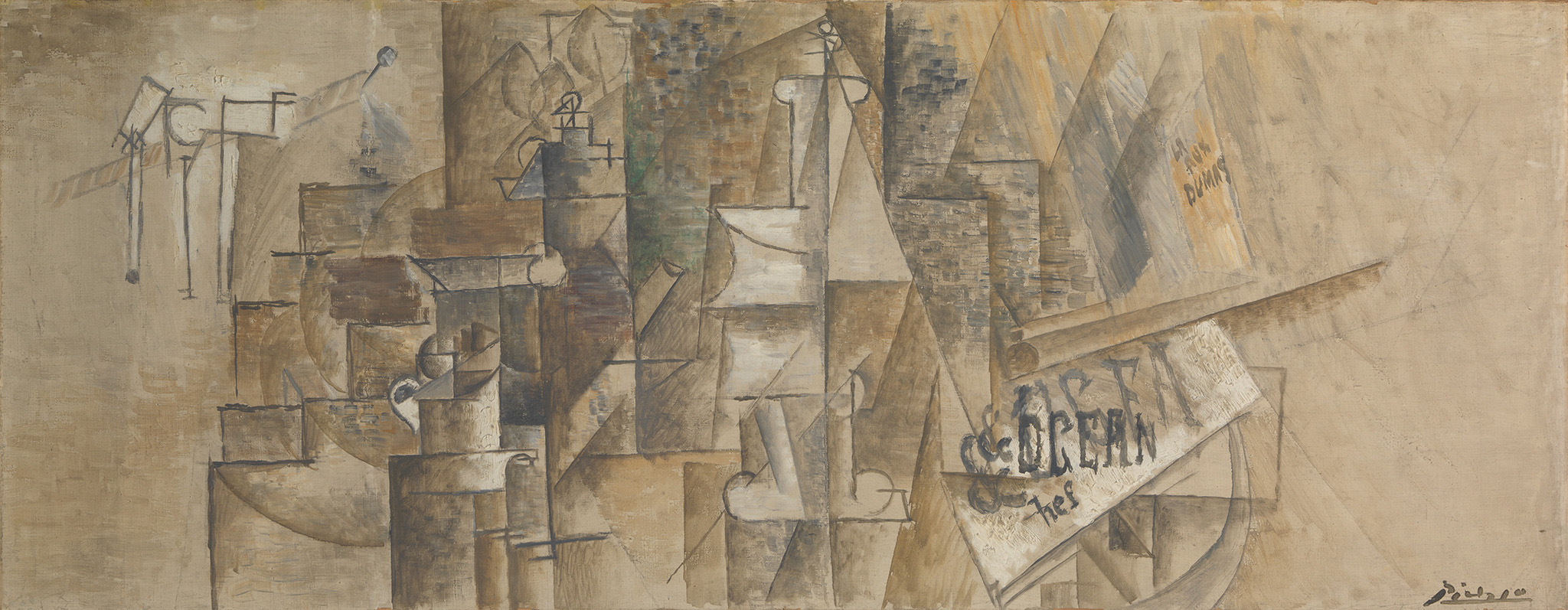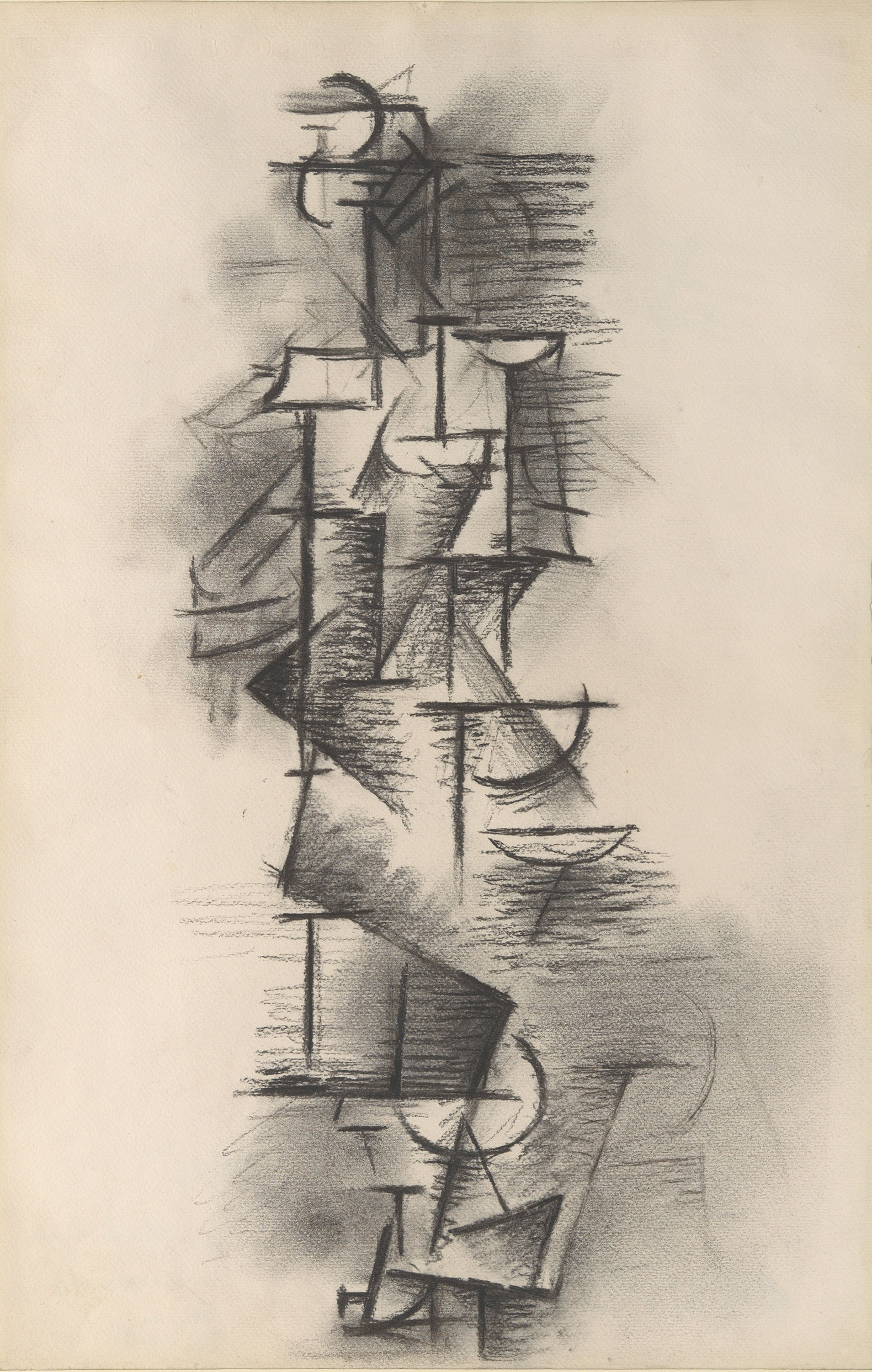In 1910, while making radical formal experiments with the human figure that brought him to the brink of abstraction, the artist embarked on a decorative commission for the Brooklyn residence of artist, collector, and critic Hamilton Easter Field (1873–1922). While the commission ultimately went unrealized, it served as a catalyst for Picasso’s exploration of Cubism, as he worked, abandoned, and reworked the panels in various studios in France.
In this focused exhibition, six paintings linked to the commission—a group of figure and still life compositions—will be brought together for the first time, along with related works and archival material. It provides a unique opportunity to view these canvases together in the same gallery and to consider them in relation to the architectural space for which they were originally intended.
In this focused exhibition, six paintings linked to the commission—a group of figure and still life compositions—will be brought together for the first time, along with related works and archival material. It provides a unique opportunity to view these canvases together in the same gallery and to consider them in relation to the architectural space for which they were originally intended.
“As the first-ever exhibition to focus on Picasso’s commission for Hamilton Easter Field, this show will uncover an important chapter in Picasso’s radical Cubist idiom and afford us a fresh angle on the artist’s transcendent work. The Met is uniquely positioned to present revelatory projects such as this because of the innovative research produced at the Leonard A. Lauder Research Center for Modern Art, our vibrant hub for scholarship on modern art in general and Cubism in particular, now in its 10th year of existence.”
Max Hollein, the Museum’s Marina Kellen French Director and CEO.

Pipe Rack and Still Life on a Table by Pablo Picasso, Summer 1911. Oil and charcoal on canvas. The Metropolitan Museum of Art, New York, The Mr. and Mrs. Klaus G. Perls Collection, 1997.
Picasso and Field met in Paris through a mutual friend in the fall of 1909, an encounter that prompted Field to offer the 28-year-old Spaniard a room in his Brooklyn Heights home—the library—to adorn with murals. The commission presented Picasso with his first opportunity to move beyond easel painting and apply his radical Cubist style to decorative painting formats of challenging size and proportion. According to artist Robert Laurent (1890–1970), the elated Picasso proclaimed that “it was just the sort of commission he had been hoping for.”
In August of the following year, Picasso received Field’s formal brief with exact details of the long and narrow room—approximately 10 x 23 feet—in which up to 11 panels were to be installed, as well as a guarantee of artistic autonomy: “I give you complete freedom,” Field declared. In 1919, a decade after meeting Picasso in Paris, Field wrote about that encounter in one of his regular art columns for his hometown newspaper, the Brooklyn Daily Eagle, remarking that the decorations were not yet finished. Field died two years later, at age 49, never having seen any of Picasso’s panels for his home library. The Field residence was demolished around 1947.
No painting by Picasso was ever linked to the commission during the artist’s lifetime. Only the discovery of a sole 1910 letter from Field, preserved in Picasso’s personal archives some 15 years after the artist’s death, allowed Picasso experts to reassess some of his unusually sized and proportioned Cubist paintings. A comparison with the dimensions of the room’s individual wall areas outlined in Field’s letter yielded several exact or near matches, prompting speculations as to how far Picasso took the project and why it remained unrealized. Field’s seemingly hands-off approach and Picasso’s difficulty in maintaining formal unity across various formats—some unusually large and others unusually narrow—were put forth as the likely impediments.

Standing Female Nude by Pablo Picasso, 1910. Charcoal on paper. The Metropolitan Museum of Art, New York, Alfred Stieglitz Collection, 1949.
With new research on Field, Picasso, and the proposed installation site, Picasso: A Cubist Commission in Brooklyn will expand beyond the initial art historical accounts of the commission and closely consider how the artist engaged with the challenge of creating a decorative ensemble. The exhibition will unfold across The Met’s Gallery 830 in four parts.
The core is devoted to six paintings associated with the commission itself. Included will be two of Picasso’s abstract Cubist figurative works of 1910—the narrow, nearly six-foot-tall Nude Woman from the National Gallery of Art, Washington, D.C., and the even more enigmatic Reclining Woman on a Sofa, a loan from a private collection. The latter represents a rare subject for Picasso’s Cubism. Oblong and horizontal, it was also the first of three overdoor panels Picasso created for the Field Library.
Two equally sized still lifes begun in the summer of 1911 in Céret and identified as the commission’s remaining two overdoors—The Met’s own Pipe Rack and Still Life on a Table and Still Life on a Piano, a loan from the Museum Berggruen—will be installed side by side for the first time. The section will also present two canvases generously lent by the Musée National Picasso-Paris, Man with a Guitar and Man with a Mandolin. The artist enlarged both with a canvas that he added along the bottom edge, nearly doubling their length. These two imposing paintings attest to a shift in interest in the size and proportion of Cubist compositions.

Reclining Woman on a Sofa by Pablo Picasso, 1910. Oil on canvas. Private Collection.
The exhibition then focuses on Field and his Brooklyn residence, featuring Field’s 1910 commissioning letter, the key textual evidence of the project. Illustrated with Field’s renderings of a wall elevation and the plan of the room allocated to Picasso, it will allow visitors to gain a sense of the architectural site. Furthering this objective is the inclusion of a decorative wooden panel executed for the Field residence by Laurent in 1913 that features floor plans of the house, including its parlor level, where the library was located.
While no designs or sketches for the commission have yet to be identified in Picasso’s vast Cubist oeuvre, a group of figurative works dated to 1910—all centered on a vertical female nude—will bring into focus the period when Picasso began working on the commission. Among the selection are three pen-and-ink drawings from the summer of 1910, including one from the Leonard A. Lauder Cubist Collection, now part of The Met’s holdings, as well as a unique oil sketch on loan from the Fundación Almine y Bernard Ruiz-Picasso para el Arte.
The exhibition concludes by contextualizing the Field Commission within Picasso’s wider presence in New York in the early decades of the 20th century, namely the artist’s first exhibition in the United States at Alfred Stieglitz’s gallery, 291, in the spring of 1911. It will feature the only two drawings sold at this landmark event, both representing a female figure: the large 1910 charcoal Cubist drawing acquired by Stieglitz, now in The Met collection, as well as a 1905–06 pen-and-ink sheet purchased by Field, a loan from the Museum of Fine Arts, Boston.
In August of the following year, Picasso received Field’s formal brief with exact details of the long and narrow room—approximately 10 x 23 feet—in which up to 11 panels were to be installed, as well as a guarantee of artistic autonomy: “I give you complete freedom,” Field declared. In 1919, a decade after meeting Picasso in Paris, Field wrote about that encounter in one of his regular art columns for his hometown newspaper, the Brooklyn Daily Eagle, remarking that the decorations were not yet finished. Field died two years later, at age 49, never having seen any of Picasso’s panels for his home library. The Field residence was demolished around 1947.
No painting by Picasso was ever linked to the commission during the artist’s lifetime. Only the discovery of a sole 1910 letter from Field, preserved in Picasso’s personal archives some 15 years after the artist’s death, allowed Picasso experts to reassess some of his unusually sized and proportioned Cubist paintings. A comparison with the dimensions of the room’s individual wall areas outlined in Field’s letter yielded several exact or near matches, prompting speculations as to how far Picasso took the project and why it remained unrealized. Field’s seemingly hands-off approach and Picasso’s difficulty in maintaining formal unity across various formats—some unusually large and others unusually narrow—were put forth as the likely impediments.

Standing Female Nude by Pablo Picasso, 1910. Charcoal on paper. The Metropolitan Museum of Art, New York, Alfred Stieglitz Collection, 1949.
With new research on Field, Picasso, and the proposed installation site, Picasso: A Cubist Commission in Brooklyn will expand beyond the initial art historical accounts of the commission and closely consider how the artist engaged with the challenge of creating a decorative ensemble. The exhibition will unfold across The Met’s Gallery 830 in four parts.
The core is devoted to six paintings associated with the commission itself. Included will be two of Picasso’s abstract Cubist figurative works of 1910—the narrow, nearly six-foot-tall Nude Woman from the National Gallery of Art, Washington, D.C., and the even more enigmatic Reclining Woman on a Sofa, a loan from a private collection. The latter represents a rare subject for Picasso’s Cubism. Oblong and horizontal, it was also the first of three overdoor panels Picasso created for the Field Library.
Two equally sized still lifes begun in the summer of 1911 in Céret and identified as the commission’s remaining two overdoors—The Met’s own Pipe Rack and Still Life on a Table and Still Life on a Piano, a loan from the Museum Berggruen—will be installed side by side for the first time. The section will also present two canvases generously lent by the Musée National Picasso-Paris, Man with a Guitar and Man with a Mandolin. The artist enlarged both with a canvas that he added along the bottom edge, nearly doubling their length. These two imposing paintings attest to a shift in interest in the size and proportion of Cubist compositions.

Reclining Woman on a Sofa by Pablo Picasso, 1910. Oil on canvas. Private Collection.
The exhibition then focuses on Field and his Brooklyn residence, featuring Field’s 1910 commissioning letter, the key textual evidence of the project. Illustrated with Field’s renderings of a wall elevation and the plan of the room allocated to Picasso, it will allow visitors to gain a sense of the architectural site. Furthering this objective is the inclusion of a decorative wooden panel executed for the Field residence by Laurent in 1913 that features floor plans of the house, including its parlor level, where the library was located.
While no designs or sketches for the commission have yet to be identified in Picasso’s vast Cubist oeuvre, a group of figurative works dated to 1910—all centered on a vertical female nude—will bring into focus the period when Picasso began working on the commission. Among the selection are three pen-and-ink drawings from the summer of 1910, including one from the Leonard A. Lauder Cubist Collection, now part of The Met’s holdings, as well as a unique oil sketch on loan from the Fundación Almine y Bernard Ruiz-Picasso para el Arte.
The exhibition concludes by contextualizing the Field Commission within Picasso’s wider presence in New York in the early decades of the 20th century, namely the artist’s first exhibition in the United States at Alfred Stieglitz’s gallery, 291, in the spring of 1911. It will feature the only two drawings sold at this landmark event, both representing a female figure: the large 1910 charcoal Cubist drawing acquired by Stieglitz, now in The Met collection, as well as a 1905–06 pen-and-ink sheet purchased by Field, a loan from the Museum of Fine Arts, Boston.











































